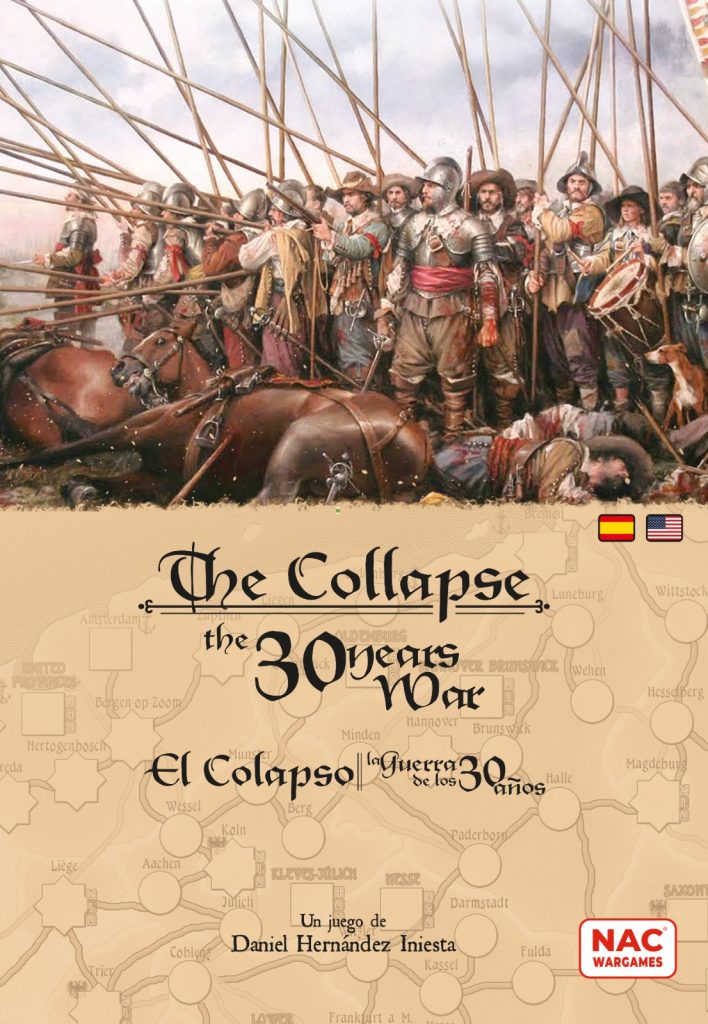
For English version of this article, please scroll down
1. Fase de Final de Turno
La fase de final de turno, se inicia cuando ambos jugadores han jugado todas sus cartas durante la fase de campaña. Se compone de varios pasos, que se deben seguir en orden y que están fácilmente indicados en la hoja de ayuda del juego.
1. Resolución de Asedios
Realiza una resolución de asedio sin coste de Puntos de Operaciones, en todas las ciudades actualmente bajo asedio.
2. Recursos
En esta fase, se suman recursos extra que ambas facciones consiguen según el paso extra de recursos de cada facción.
2.1 Recursos extra católicos
- En función del espacio que ocupe del marcador de la Estabilidad de España.
- Según el espacio con la condición de aliado católico, que ocupe el marcador de la Alianza del Papado.
- El católico reduce los recursos extra totales recibidos por bloqueos navales, y si la región de Génova está controlada por el protestante.
2.2 Recursos extra protestantes
- En función del espacio ocupado con el valor de recursos más alto de las alianzas activas de Dinamarca, Suecia o Francia.
- Por cada Bloqueo Naval.
3. Eliminación Imperial de Revueltas
La facción que actualmente tiene la ficha del Emperador, puede eliminar fichas de revuelta según su nivel de prestigio.
4. Desgaste
Una unidad que sufre desgaste, da la vuelta a la unidad de su lado de fuerza completa a su lado de fuerza reducida, o si la unidad ya está en su lado de fuerza reducida, retira la unidad a la reserva. Durante este paso, cualquier unidad fuera de sus Regiones Natales o Regiones que no controle sino paga 1 recurso por cada unidad.
5. Incursiones de los Corsarios de Dunkerque
Los ‘Corsarios de Dunkerque’, eran navegantes que apoyaban los esfuerzos bélicos del Rey de España en Flandes, mediante acciones navales (corsarias principalmente) contra los barcos de las Provincias Unidas en el mar del Norte desde el puerto de Dunkerque. También se utilizaron en ocasiones para el transporte de tropas españolas a Flandes, a través del mar desde la costa española. Si Dunkerque y/o Amberes están bajo control católico, pueden reducir los recursos extra del protestante en una tirada de dados.
6. Despliegue de los Tercios
Solo los Tercios (veteranos españoles) en Lombardía, pueden moverse desde Lombardía a Flandes a través de ciudades neutrales y/o controladas por el católico hasta la ciudad de Luxemburgo, a través del Camino Español. Todos los Tercios que se mueven desde Lombardía deben mover juntos, y no sufren Desgaste.
7. Propagación de Revueltas
Las revueltas en el mapa, se pueden propagar a ciudades adyacentes.
8. Puntos de Prestigio
Este paso, un jugador puede ganar puntos de prestigio extra en unas condiciones concretas.
9. Comprobación de Victoria
Una facción consigue la victoria en el juego si el marcador de Puntos de Victoria está en su lado, al final del escenario que se está jugando. Si el valor es 0, se considera un empate.
Existe la opción de que una facción consiga una victoria automática en cualquier momento del juego, cuando se produce una de las siguientes opciones:
- Controla TODAS las Capitales (las de su facción, y las del enemigo)
- No existe ninguna unidad enemiga en el mapa
- La facción enemiga no controla ninguna región
Por otro lado, si el valor de Puntos de Victoria es 0 al final del turno 10, o si los jugadores deciden extender los turnos de juego al finalizar un escenario, determina la victoria final con ciertos modificadores.

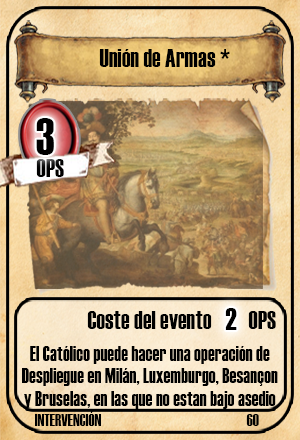

Foto: Cartas de Revolución, Intervención y Conclusión
3. El Camino Español, juego para la 6ª edición de las Bellota Con
El juego del Camino Español está diseñado en exclusividad para la Convención de wargames y juegos históricos Bellota Con VI celebrada entre los días 26 y 29 de enero de 2023 en Badajoz-España. El arte gráfico es obra del reputado diseñador Nils Johansson. El juego describe el período de 1567 a 1634, buscando reflejar la tensión y dificultades del traslado de tropas españolas a Flandes con 3 generales de la Monarquía Hispánica (Duque de Alba, Ambrosio Spínola y el Cardenal Infante Fernando).
Durante la convención recibiréis por parte de la organización una copia gratuita del juego en formato A3 y una sorpresa muy interesante, para que conozcáis un poco más la historia e importancia del Camino Español. Además, en la mesa donde tendré para mostrar El Colapso, donde tendré todo el material en español e inglés, podréis ver una copia a un tamaño mayor que en A3 de El Camino Español para que podáis conocer mejor el juego. El viernes a la noche (hacia las 22.00), tengo organizada una partida matrix de El Colapso con ocho jugadores que os animo a venir a verla, será muy divertida.
Venid a conocer más sobre El Colapso, wargame estratégico con motor de cartas común CDG sobre la guerra de los 30 años (1618-1648).

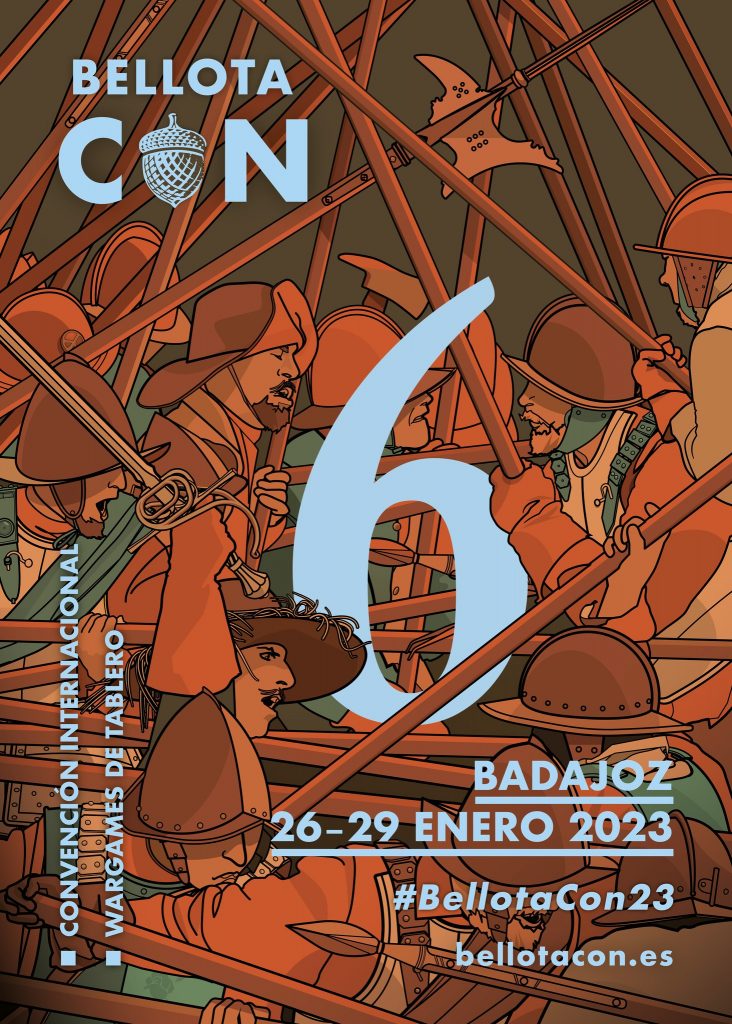
4. ¿Que vendrá en el próximo artículo?
¡En el próximo artículo, podréis tener más información detallada sobre la 6! Edición de las Bellota Con que se celebran entre los días 26 y 29 de enero de 2023.
El juego está actualmente en reserva en la página web de NAC Wargames y Mas que Oca (sin solicitud de pago), donde podéis apoyar la publicación del juego con vuestro registro en https://t.co/yPf87XEdw9
Si tienes alguna pregunta o quiere que amplíe un artículo o escriba sobre algo que le interese, hágamelo saber con un comentario sobre este artículo, envíame un correo electrónico a daniel.hndez@gmail.com y siga las noticias del juego en Twitter (@HndezDaniel).

AUTOR DEL JUEGO: DANIEL HERNÁNDEZ INIESTA
Article in English (for the Spanish version of the article, please look at the top of the article)
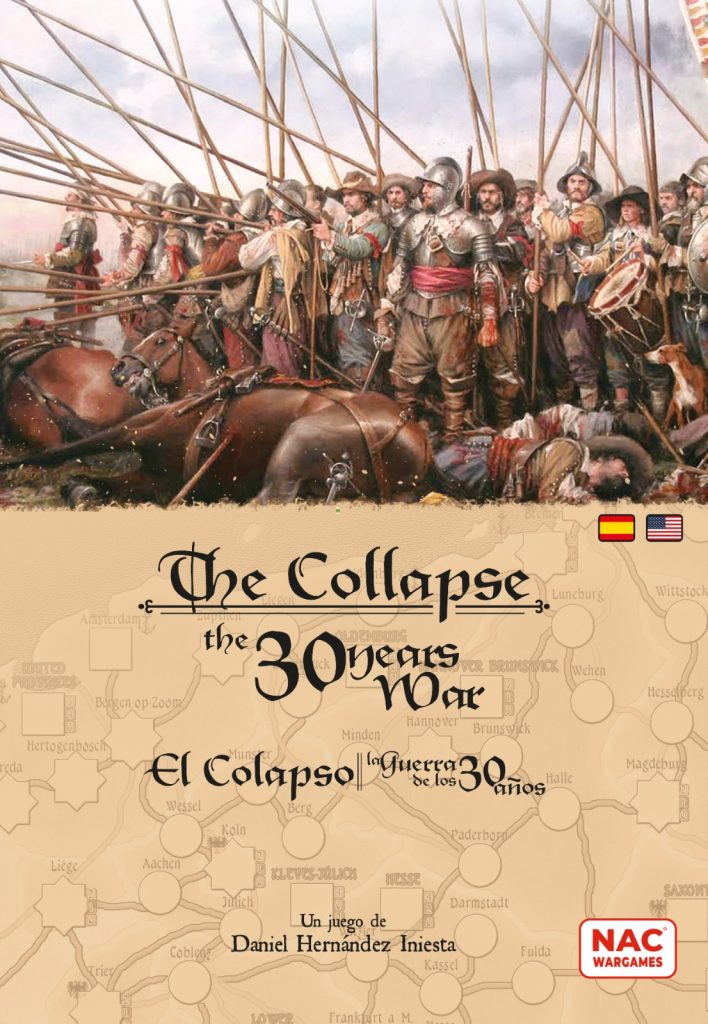
1. End of Turn Phase
The end of turn phase begins when both players have played all their cards during the campaign phase. It consists of several steps, which must be followed in order that are easily explained on the player aid’ cards.
1. Siege Resolution
Perform a siege resolution at no cost of Operations Points, in all cities currently under siege.
2. Resources
In this phase, extra resources are added that both factions according to each faction’ extra resource options.
2.1 Extra catholic resources
- Depending on the space occupied by the Spain Stability marker.
- Depending on the space with the status of Catholic ally, which occupies the Papacy alliance marker.
- The Catholic reduces the total extra resources received from naval blockades, and also if Genoa region is controlled by the Protestant.
2.2 Extra Protestant Resources
- Based on the space occupied with the highest resource value of the active Danish, Swedish, or French alliances.
- For each Naval Blockade.
3. Emperor Revolts Removal
The faction that currently has the emperor token can remove revolt tokens based on their prestige level.
4. Attrition
A unit that suffers attrition flips the unit from its full-strength side to its reduced-strength side, or if the unit is already on its reduced strength side, removes the unit to the Force’ pool. During this step, any units outside of their Home Regions or Regions not friendly-controlled must pay 1 resource for each unit or will suffer attrition.
5. Dunkirk Privateers Raids
The ‘Dunkirk Privateers’, were sailors who supported the King of Spain war efforts in Flanders, through naval actions (mainly corsairs) against the United Provinces ships in the North Sea from the port of Dunkirk. They were also used on occasions for the Spanish troops transport to Flanders, across the sea from the Spanish coast. If Dunkirk and/or Antwerp are under Catholic control, the Protestant’s extra resources may be reduced.
6. Tercios Deployment
Only Tercios (Spanish veterans) in Lombardy may move from Lombardy to Flanders through neutral and/or Catholic-controlled cities to Luxembourg City across ‘Camino Español’ (the Spanish Road). All Tercios moving from Lombardy must move together, and suffer no attrition.
7. Revolt Spread
Revolts on the map can spread to adjacent minor cities.
8. Prestige Points
In this step, a player can earn extra prestige points under certain conditions.
9. Victory Check
A faction achieves victory in the game, if the Victory Point marker is on its side at the end of the scenario being played. If the value is 0, it is considered a stalemate.
On the other hand, if the Victory Point value is 0 at the end of turn 10, or if the players decide to extend the game at the end of a scenario, determine final victory with the following modifiers:
- According to the Prestige level of each faction:
- +2 Victory Points, if Prestige is HIGH
- +1 Victory Point, if Prestige is MEDIUM
- + 1 Victory Point for each Electorate controlled by each player
- + 2 Victory Points for the faction with the emperor marker
If the Victory Points marker is still at 0, a final stalemate is considered to have been achieved.
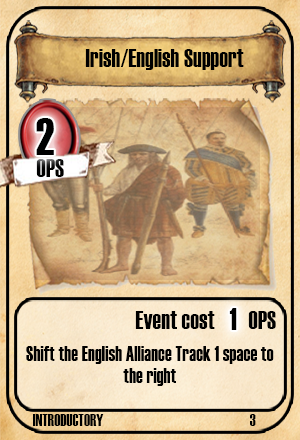
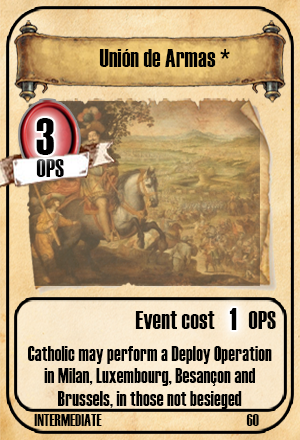
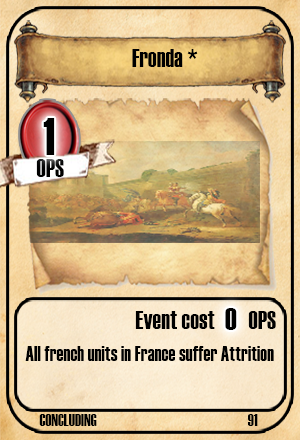
Photo: Revolution, Intervention and Conclusion Cards
3. El Camino Español (The Spanish Road), game for the 6th edition of Bellota Con
‘El Camino Español’ game is designed especially for the Bellota Con VI Wargames and Historical Games Convention to be held between January 26 and 29, 2023 in Badajoz (Spain). The game’ graphic art has been made by the well-renowned designer Nils Johansson. The game describes the period from 1567 to 1634, seeking to reflect the tension and difficulties to march Spanish troops (mainly the famous veterans ‘Tercios’) to Flanders, with 3 possible Spanish generals (Duke of Alba, Ambrosio Spínola and Cardinal Infante Fernando).
During the convention you will receive from the organization a free copy of the game in A3 format and a very interesting surprise, so that you can learn a little more about the history and importance of the Spanish Road. In addition, on the table where I will have to show The Collapse, where I will have all the material in Spanish and English, you will be able to watch a copy of the Spanish Road larger than A3 so that you can get to know the game better. On Friday night (around 10:00 p.m.), I have organized a matrix game of The Collapse with eight players that I encourage you to come to watch, that will be very funny!
Come to learn more about The Collapse, a strategic wargame with a common CDG card drive game about the 30 years’ war (1618-1648).
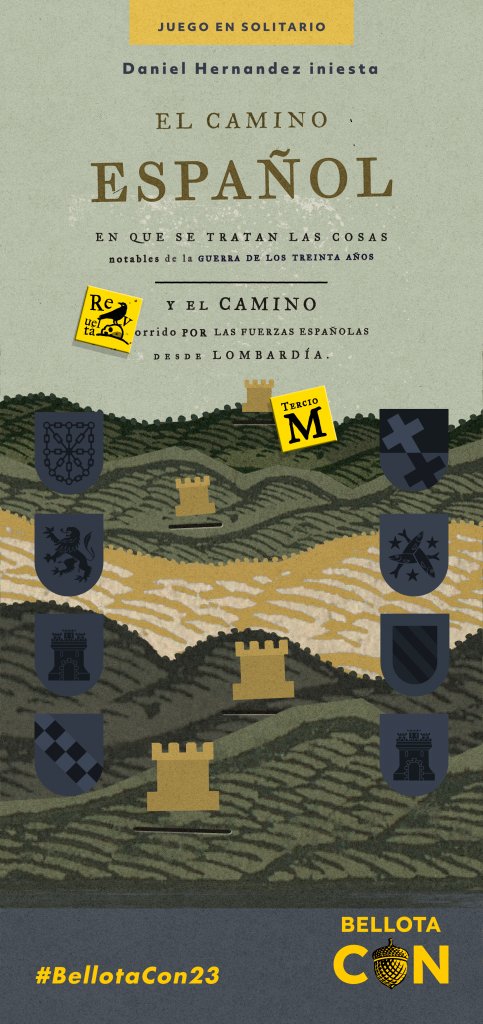
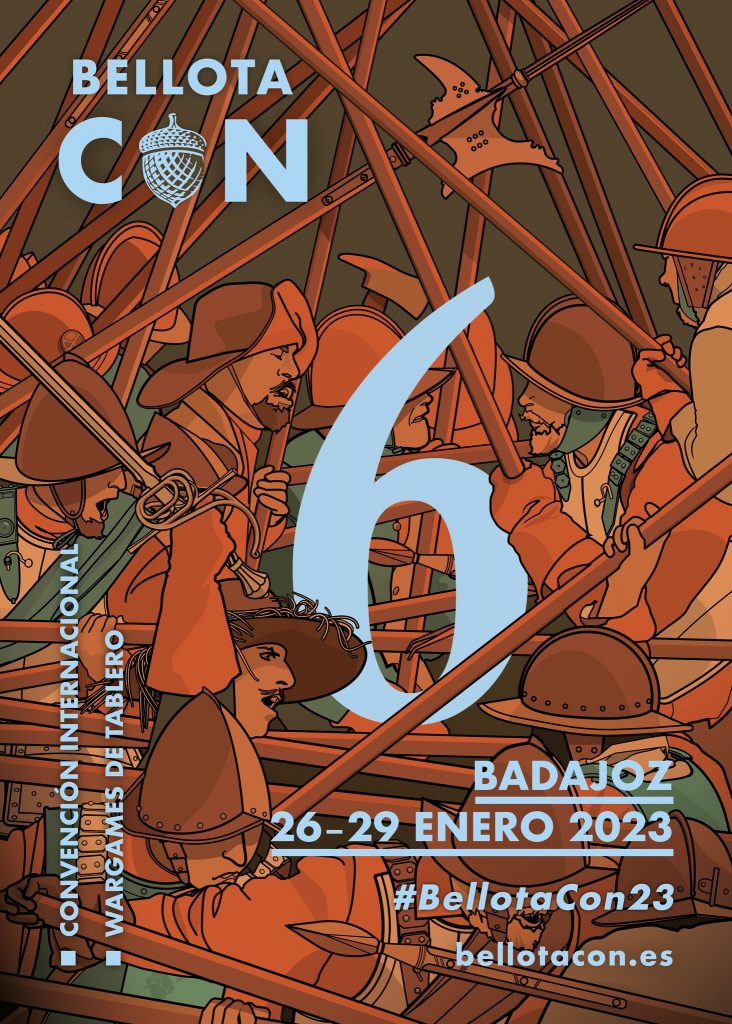
4. What will come in the next article?
In the next article, you will be able to have more detailed information about the presentation of ‘The Collapse’ at the Bellota Con VI convention (matrix game, games play information, map, cards, markers and much more), as well as a game preview of ‘El Camino Español’, specially designed to give as a gift to the people attending the Bellota Con VI. #BellotaCon23
Photo and logo of the Bellota Con VI and QR code photo
The game is currently on pre-order on the NAC Wargames and Mas que Oca website (without payment request), where you can support the publication of the game with your registration at https://t.co/yPf87XEdw9
If you have any questions or want me to expand on an article or write about something that interests you, please let me know by commenting on this article, email me at daniel.hndez@gmail.com, and follow the game updates on Twitter (@HndezDaniel).

GAME DESIGNER: DANIEL HERNÁNDEZ INIESTA

